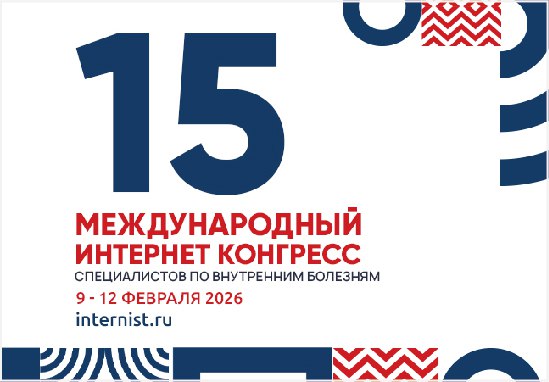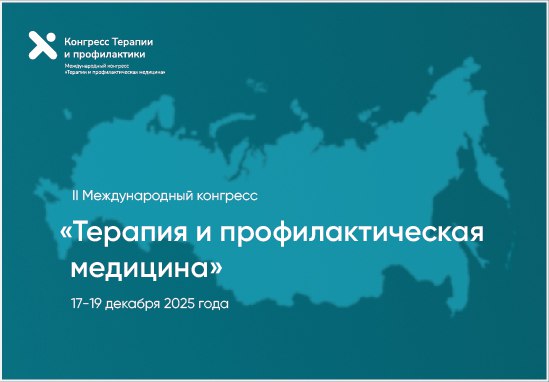Cytokine hemoadsorption in myocardial infarction-associated cardiogenic shock: protocol for a randomized clinical trial
https://doi.org/10.20996/1819-6446-2025-3198
EDN: UWGGRQ
Abstract
Aim. To evaluate the efficacy and safety of cytokine hemoadsorption using the Efferon®CT device in patients with myocardial Infarction-associated shock at SCAI (Society for Cardiovascular Angiography and Interventions) stages B-C.
Material and methods. This is a protocol of an open-label, single-center, randomized controlled clinical trial. A total of 60 patients aged 18-80 years with myocardial Infarction-associated shock diagnosed within 4 hours prior to randomization will be enrolled. Participants will be randomized (1:1) to the intervention group (standard therapy + hemoadsorption, n=30) or the control group (standard therapy, n=30). Primary endpoint: time to clinical stabilization (hemodynamic normalization with discontinuation of vasopressor and mechanical support, sustained ≥4 hours). Secondary endpoints: hemodynamic parameters, oxygenation index, SOFA (Sequential Organ Failure Assessment) score, incidence of acute kidney injury (Kidney Disease: Improving Global Outcomes, KDIGO), duration and need for mechanical ventilation, intensive care unit and hospital length of stay, dynamics of inflammatory and organ function markers.
Expected results. Hemoadsorption with Efferon®CT is expected to remove pro-inflammatory molecules of medium molecular weight, thereby improving macro- and microcirculation, reducing multiple organ dysfunction, and decreasing the need for vasopressor support.
Conclusion. This study aims to provide the first evidence on the efficacy and safety of early cytokine hemoadsorption in myocardial Infarction-associated shock. The findings may support its pathophysiological rationale and form the basis for large-scale multicenter trials and potential updates of clinical practice guidelines.
Keywords
About the Authors
M. A. KerchevaRussian Federation
Maria A. Kercheva
Tomsk
S. V. Dil
Russian Federation
Stanislav V. Dil
Tomsk
A. A. Rumyantseva
Russian Federation
Anastasia A. Rumyantseva
Tomsk
O. O. Panteleev
Russian Federation
Oleg O. Panteleev
Tomsk
I. V. Kologrivova
Russian Federation
Irina V. Kologrivova
Tomsk
I. I. Yolgin
Russian Federation
Ivan I. Yolgin
Tomsk
A. A. Dmitriukov
Russian Federation
Alexey A. Dmitriukov
Tomsk
V. V. Ryabov
Russian Federation
Vyacheslav V. Ryabov
Tomsk
References
1. McDonagh TA, Metra M, Adamo M, et al.; ESC Scientific Document Group. 2021 ESC Guidelines for the diagnosis and treatment of acute and chronic heart failure. Eur Heart J. 2021;42(36):3599-726. DOI:10.1093/eurheartj/ehab670. Еrratum in: Eur Heart J. 2021;42(48):4901. DOI:10.1093/eurheartj/ehab670.
2. Ponikowski P, Voors AA, Anker SD, et al.; ESC Scientific Document Group. 2016 ESC Guidelines for the diagnosis and treatment of acute and chronic heart failure. Eur Heart J. 2016;37(27):2129-200. DOI:10.1093/eurheartj/ehw128. Erratum in: Eur Heart J. 2018;39(10):860. DOI:10.1093/eurheartj/ehw383.
3. Naidu SS, Baran DA, Jentzer JC, et al. SCAI SCAI SHOCK Stage Classification Expert Consensus Update: A Review and Incorporation of Validation Studies: This statement was endorsed by the American College of Cardiology (ACC), American College of Emergency Physicians (ACEP), American Heart Association (AHA), European Society of Cardiology (ESC) Association for Acute Cardiovascular Care (ACVC), International Society for Heart and Lung Transplantation (ISHLT), Society of Critical Care Medicine (SCCM), and Society of Thoracic Surgeons (STS) in December 2021. J Am Coll Cardiol. 2022;79(9):933-46. DOI:10.1016/j.jacc.2022.01.018.
4. Samsky MD, Morrow DA, Proudfoot AG, et al. Cardiogenic shock after acute myocardial infarction: a review. JAMA. 2021;326(18):1840-50. DOI:10.1001/jama.2021.18323. Erratum in: JAMA. 2021;326(22):2333. DOI:10.1001/jama.2021.21381.
5. Calabrò MG, Febres D, Recca G, et al. Blood purification with CytoSorb in critically ill patients: single-center preliminary experience. Artif Organs. 2019;43(2):189-94. DOI:10.1111/aor.13327.
6. Dogan G, Hanke J, Puntigam J, et al. Hemoadsorption in cardiac shock with biventricular failure and giant-cell myocarditis: a case report. Int J Artif Organs. 2018;41(8):474-9. DOI:10.1177/0391398818777362.
7. Träger K, Skrabal C, Fischer G, et al. Hemoadsorption treatment with CytoSorb® in patients with extracorporeal life support therapy: a case series. Int J Artif Organs. 2020;43(6):422-9. DOI:10.1177/0391398819895287.
8. Kologrivova I, Kercheva M, Panteleev O, Ryabov V. The role of inflammation in the pathogenesis of cardiogenic shock secondary to acute myocardial infarction: a narrative review. Biomedicines. 2024;12(9):2073. DOI:10.3390/biomedicines12092073.
9. Novosadov MM, Novosadov VM, Dzhioeva ON, Drapkina OM. Practical aspects of managing patients with cardiogenic shock. Russian Journal of Cardiology. 2023;28(1S):5337. (In Russ.) DOI:10.15829/1560-4071-2023-5337.
10. Lüscher TF, Thiele H. Cardiogenic shock: do we need a paradigm shift? Eur Heart J. 2024;45(39):4178-80. DOI:10.1093/eurheartj/ehae425.
11. Jentzer JC, Lawler PR, Van Diepen S, et al. Systemic inflammatory response syndrome is associated with increased mortality across the spectrum of shock severity in cardiac intensive care patients. Circ Cardiovasc Qual Outcomes. 2020;13(12):e006956. DOI:10.1161/CIRCOUTCOMES.120.006956.
12. Kercheva MA, Ryabov VV, Gombozhapova AЕ, et al. Place of the cardiosplenic axis in the development of fatal myocardial infarction. Russian Journal of Cardiology. 2023;28(5):5411 (In Russ.) DOI:10.15829/1560-4071-2023-5411.
13. Vasyuk YA, Dudarenko OP, Yushchuk EN, et al. «Cytokine» model of pathogenesis of chronic heart failure and prospects of new therapeutic approach in decompensated patients. Rational Pharmacotherapy in Cardiology 2006;2(4):63-70 (In Russ.) DOI:10.20996/1819-6446-2006-2-4-63-70.
14. Serdechnaya AYu, Sukmanova IA. Modern approaches to the diagnosis and treatment of cardiogenic shock complicating acute myocardial infarction Cardiovascular Therapy and Prevention. 2020;19(5):2661 (In Russ.) DOI:10.15829/1728-8800-2020-2661.
15. Sarana AM, Shcherbak SG, Vologzhanin DA, et al. Efferent methods of therapy for critical illness. Phys Rehabil Med Med Rehabil. 2024;6(1):49-72 (In Russ.) DOI:10.36425/rehab626652.
16. Kreutz J, Harbaum L, Barutcu CB, et al. CytoSorb® hemadsorption in cardiogenic shock: a real-world analysis of hemodynamics, organ function, and clinical outcomes during mechanical circulatory support. Biomedicines. 2025;13(2):324. DOI:10.3390/biomedicines13020324.
17. Pausch J, Mersmann J, Bhadra OD, et al. Preliminary experience of extracorporeal cytokine hemoadsorption during left ventricular assist device implantation in cardiogenic shock patients. Thorac Cardiovasc Surg. 2022;72(4):266-72. DOI:10.1055/s-0042-1757300.
18. Dil SV, Kirilin VV, Ivanov NM, Ryabov VV. Diagnosis and treatment of sepsis-induced cardiomyopathy using hemoadsorption therapy: a case report Russ J Cardiol. 2023;28(7):5355 (In Russ.) DOI:10.15829/1560-4071-2023-5355.
19. Collet JP, Thiele H, Barbato E, et al. 2020 ESC Guidelines for the management of acute coronary syndromes in patients presenting without persistent ST-segment elevation. Eur Heart J. 2021;42(14):1289-367. DOI:10.1093/eurheartj/ehaa575.
20. Zeymer U, Bueno H, Granger CB, et al. Acute Cardiovascular Care Association position statement for the diagnosis and treatment of patients with acute myocardial infarction complicated by cardiogenic shock. Eur Heart J Acute Cardiovasc Care. 2020;9(2):183-97. DOI:10.1177/2048872620902438.
21. Khwaja A. KDIGO clinical practice guidelines for acute kidney injury. Nephron Clin Pract. 2012;120(4):179-84. DOI:10.1159/000339789.
22. Gaies MG, Gurney JG, Yen AH, et al. Vasoactive-inotropic score as a predictor of morbidity and mortality in infants after cardiopulmonary bypass. Pediatr Crit Care Med. 2010;11(2):234-8. DOI:10.1097/PCC.0b013e3181b806fc.
23. Charlson ME, Pompei P, Ales KL, MacKenzie CR. A new method of classifying prognostic comorbidity in longitudinal studies: development and validation. J Chronic Dis. 1987;40(5):373-83. DOI:10.1016/0021-9681(87)90171-8.
24. Kikkert W, van Geloven N, van der Laan M, et al. The Prognostic Value of Bleeding Academic Research Consortium (BARC)-Defined Bleeding Complications in ST-Segment Elevation Myocardial Infarction: A Comparison With the TIMI (Thrombolysis In Myocardial Infarction), GUSTO (Global Utilization of Streptokinase and Tissue Plasminogen Activator for Occluded Coronary Arteries), and ISTH (International Society on Thrombosis and Haemostasis) Bleeding Classifications. JACC. 2014, 63(18):1866-75. DOI:10.1016/j.jacc.2014.01.069.
25. Tehrani BN, Truesdell AG, Psotka MA, et al. A standardized and comprehensive approach to the management of cardiogenic shock. JACC Heart Fail. 2020;8(11):879-91. DOI:10.1016/j.jchf.2020.09.005.
26. Pantleeev OO, Vyshlov EV, Kercheva MA, Ryabov VV. Analysis of results of intra-aortic balloon counterpulsation in cardiogenic shock in myocardial infarction patients. Sib J Clin Exp Med. 2022;37(2):21-7. (In Russ.) DOI:10.29001/2073-8552-2022-37-2-21-27.
27. Kaddoura R, Elbdri S. Current evidence in the diagnosis and management of cardiogenic shock complicating acute coronary syndrome. Rev Cardiovasc Med. 2021;22(3):691-715. DOI:10.31083/j.rcm2203078.
28. Kirov MYu, Kuzkov VV, Protsenko DN, et al. Septic shock in adults: clinical recommendations of the All-Russian Public Organization “Federation of Anesthesiologists and Intensive Care Specialists” Vestn Intensiv Ter Im A I Saltanova. 2023;(4):7-42. (In Russ.) DOI:10.21320/1818-474X-2023-4-7-42.
29. Thangam M, Luke AA, Johnson DY et al. Sociodemographic differences in utilization and outcomes for temporary cardiovascular mechanical support in the setting of cardiogenic shock. Am Heart J. 2021;236:87-96. DOI:10.1016/j.ahj.2020.12.014.
30. Urina Jassir D, Chaanine AH, Desai S, et al. Therapeutic dilemmas in mixed septic-cardiogenic shock. Am J Med. 2023;136(1):27-32. DOI:10.1016/j.amjmed.2022.09.022.
31. Berg DD, Bohula EA, van Diepen S, et al. Epidemiology of shock in contemporary cardiac intensive care units: data from the Critical Care Cardiology Trials Network Registry. Circ Cardiovasc Qual Outcomes. 2019;12(3):e005958. DOI:10.1161/CIRCOUTCOMES.119.005618.
32. Dil S, Kercheva M, Belich N, et al. Stage A Cardiogenic Shock in the SCAI Classification: Limitations and Prospects for Diagnostic Improvement. Cardiol Rev. 2025. DOI:10.1097/CRD.0000000000001027. Epub ahead of print.
33. Jentzer JC, Ahmed AM, Vallabhajosyula S, et al. Shock in the cardiac intensive care unit: changes in epidemiology and prognosis over time. Am Heart J. 2021;232:94-104. DOI:10.1016/j.ahj.2020.10.054.
34. Kim AR, Hyun J, Lee SE, et al. Prognosis of venoarterial extracorporeal membrane oxygenation in mixed, cardiogenic and septic shock. ASAIO J. 2023;69(7):658-64. DOI:10.1097/MAT.0000000000001933.
35. Van Diepen S, Katz JN, Albert NM, et al.; American Heart Association Council on Clinical Cardiology; Council on Cardiovascular and Stroke Nursing; Council on Quality of Care and Outcomes Research; and Mission: Lifeline. Contemporary Management of Cardiogenic Shock: A Scientific Statement From the American Heart Association. Circulation. 2017;136(16):e232-68. DOI:10.1161/CIR.0000000000000525.
36. Dil SV, Kercheva M, Panteleev O, et al. Myocardial infarction-associated shock: a comprehensive analysis of phenotypes, SCAI classification, and outcome assessment. Medicina (Kaunas). 2025;61(1):103. DOI:10.3390/medicina61010103.
Supplementary files
Review
For citations:
Kercheva M.A., Dil S.V., Rumyantseva A.A., Panteleev O.O., Kologrivova I.V., Yolgin I.I., Dmitriukov A.A., Ryabov V.V. Cytokine hemoadsorption in myocardial infarction-associated cardiogenic shock: protocol for a randomized clinical trial. Rational Pharmacotherapy in Cardiology. 2025;21(4):318-326. (In Russ.) https://doi.org/10.20996/1819-6446-2025-3198. EDN: UWGGRQ
















































